Interesting ancient coins, offered by Augustus Coins
If you want to buy ancient coins and you are in the US, you are beginning at the right page. If you want to learn more about ancient coins, visit my educational ancient-coin website (begun in 1997 and expanded very many times since then). If you like to learn from books, visit my page of ancient-coin literature. For more about me, see see here.
Contents: This is the main page with Roman coins and some of newest listings from other series too, at the top. For late Roman, Byzantine, or Greek coins, or books about them, use the links to the left.
Skip down to Republican, 1st C, 2nd C, or 3rd C , Tetrarchy (Diocletian - Licinius II). (Links to other series are on the left sidebar.)
Recent: 2025, Dec. 18: Galerius. A few prices reduced.
2025, Dec. 16: A very large Tiberius II, Justin I with standing emperor (formerly given to Justin II), large Constans II from Sicily, and a Heraclius from Thessaloncia (on the Byzantine page).
2025, Dec. 11: CONSTANTINOPOLIS/GLORIA EXERCITVS and Constantine II/ALAMANIA DEVICTA on the Constantinian page. A super example of a type, VRBS ROMA, just for Valentinian II, on this page. Anonymous Class H, apparently scarce (none on vcoins) on the Byzantine page. Nice AE2s of Theodosius and Honorius on the Valentinian and later page.
2025, Dec. 3: The best reverse for Claudius II, Gothicus. Constantius II. Julian II bull. This page. On the Valentinian page: Valentinian R PRIMA. Eudoxia, wife of Arcadius. Tancred's fourth type of four on the Byzantine page.
2025, Dec. 1: Honorius, anonymous civic issue of Antioch under Maximinus II (this page).
wwestyc wwestypage
Prices are in brackets: [$xx].
To order or simply to ask me questions, write me, Warren, at  .
.
(I am on Pacific time, so if you are in the east and write me at 8:00 am it is only 5:00 am where I am.)
My page of terms, which are essentially repeated here:
All coins are guaranteed genuine.
Terms of Sale. If you are in the US you can pay with Zelle (preferred) or PayPal to my e-mail address. (I also accept checks.) (Why I prefer Zelle.) Do not pay until after I confirm I still have the coin.
Please tell me if you are not in the US. I don't often ship outside the US becaue shipping is so expensive. If you are outside the US, shipping would be $18 to Canada and $20 (or slightly more for a big order) to elsewhere. (I'm very sorry shipping outside the US is so expensive.) Please pay with Wise if you can. See more here.
Shipping in the US is $2 for orders under $25, $3 up to $50, $4 up to $100, and an additional $2 for each hundred thereafter.
Reminder: When you buy a coin you must add in the shipping cost. Don't think a coin offered at $20 elsewhere will cost you $20. It won't. Shipping could easily be $6, $10, or $15, or more. In contrast, I charge only $2 for shipping a $20 coin in the US.
Purple means "SOLD" and no longer available
Newest first. After that, Roman coins before the 4th century are in chronological order below. Later Roman coins are on other pages linked in the sidebar.
(Greek, Byzantine, and other coins are on other pages (with links at the upper left of this page).
Go down to Roman coins in chronological order
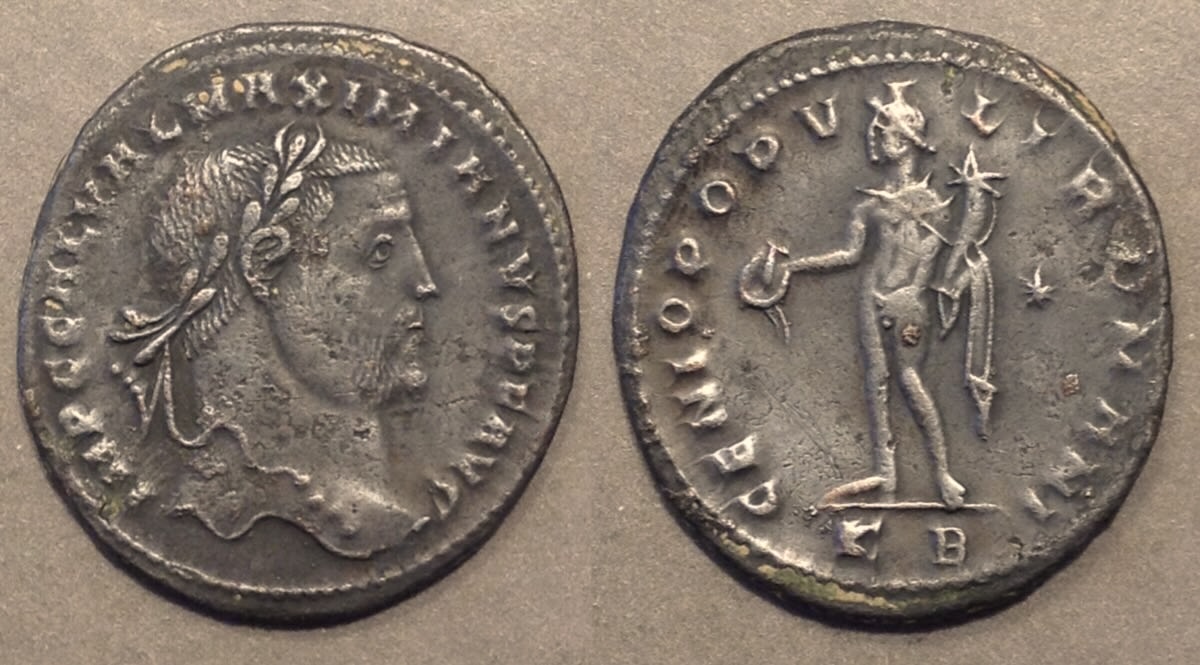 Galerius, 293-305-311
Galerius, 293-305-311
27.2 - 25.4 mm. 8.63 grams.
Follis.
IMP C GAL VAL MAXIMIANVS PF AVG
Laureate head right
GENIO POPVLI ROMANI
*
K B
RIC VI Cyzicus 27a, as Augustus, 25 July 306 - Dec. 308. "Scarce"
Dark slate gray. Formerly repatinated. I removed the artificial surface. The surface is stable.
Larger than a US quarter. [$24]
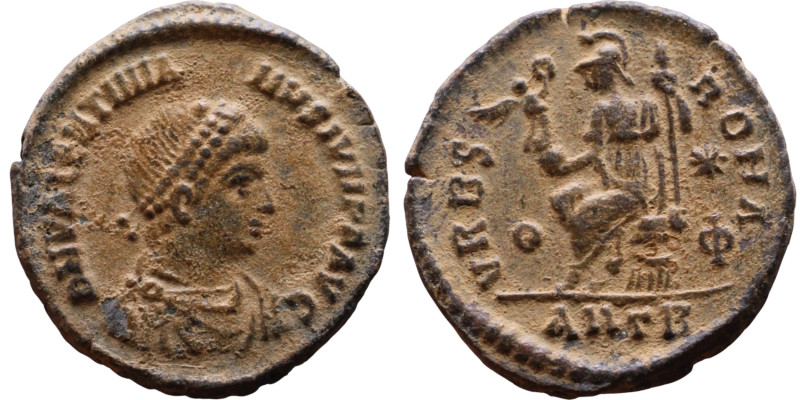 Valentinian II
Valentinian II
375-392
19 mm.
Note the overse legend has "IVN" in it for "Junior"
DN VALENTINIANVS IVN PF AVG
A type just for him.
VRBS ROMA
Roma seated on cuirass, holding Victory and scepter
A very nice example, better than the $155 one on vcoins.
and much better than the $105 and $60 ones.
A lovely coin of a good type [$45]
RIC IX Antioch 51 (with field and mintmark variety 6), only for Valentinian II.
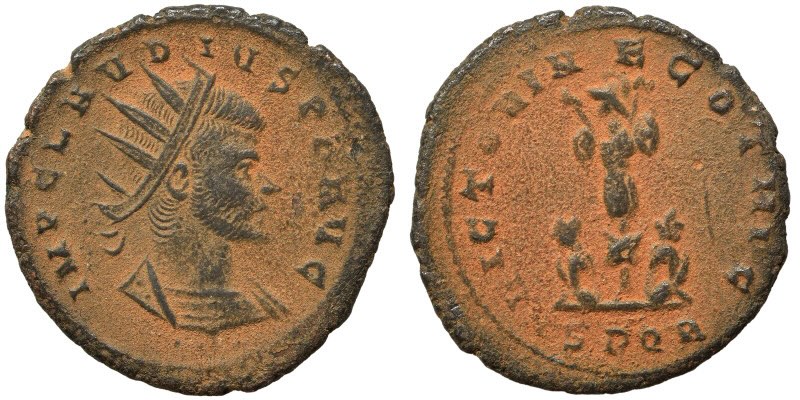 Claudius II, Gothicus
Claudius II, Gothicus
20 mm. 3.32 grams. Repatinated.
IMP CLAVDIVS PF AVG
VICTORIA GOTHIC, trophy and two captives
SPQR
The "SPQR" mint, which is worth collecting on its own. Now scholars think it is Cyzicus, although I don't consider it certain.
The best reverse type for Claudius II because it has his nickname "Gothicus" and is from the desirable SPQR mint.
RIC Cyzicus 252 "Rare"
A beautiful exmple [$69 SOLD]
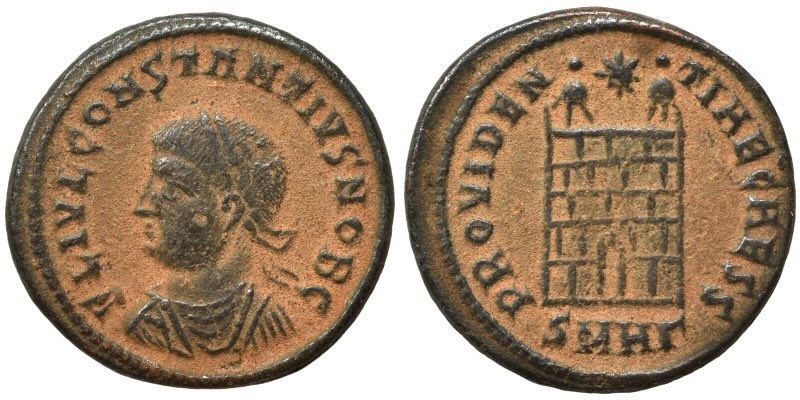 Constantius II
Constantius II
19 mm. 3.02 grams. Repatinated.
PROVIDENTIAE CAESS
SMHΓ for Heraclea mint
FL IVL CONSTANTIVS NOB C
[$18]
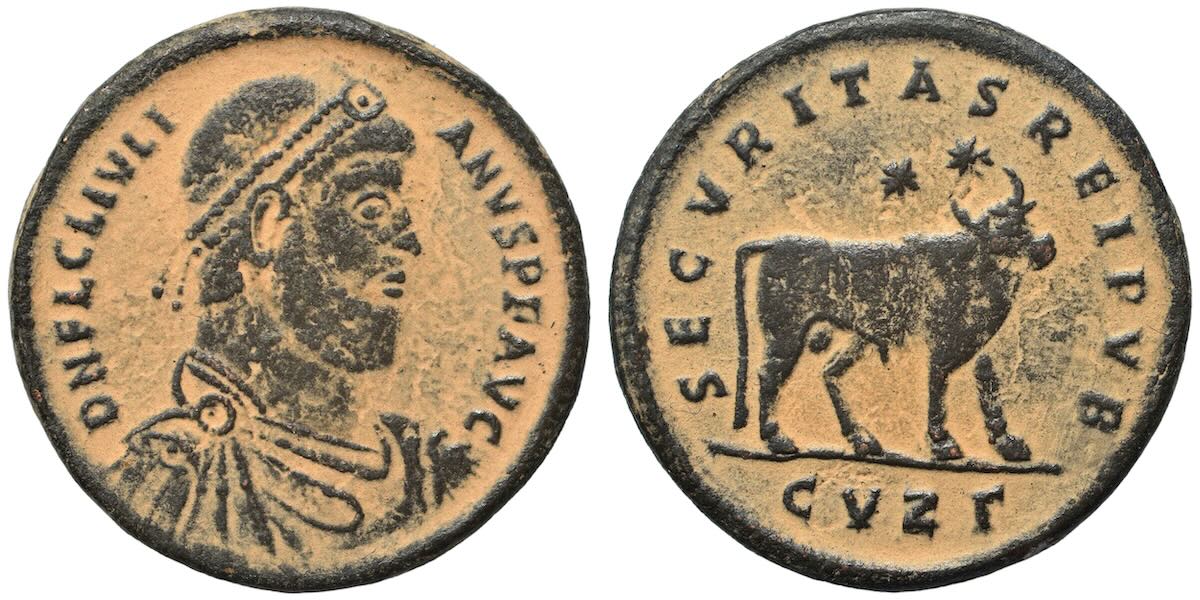 Julian II, the Apostate
Julian II, the Apostate
His famous "bull" type.
28 mm. 9.04 grams. Repatinated. Large AE1.
SECVRITAS REIPVB
CVZΓ
This type has been much discussed. It got Julian in trouble at Antioch for being too pagan. We are not certain which among many possible bulls is represented. A web search will find many opinions. An interesting type.
A nice big coin, significantly larger than a US quarter.
[$95]
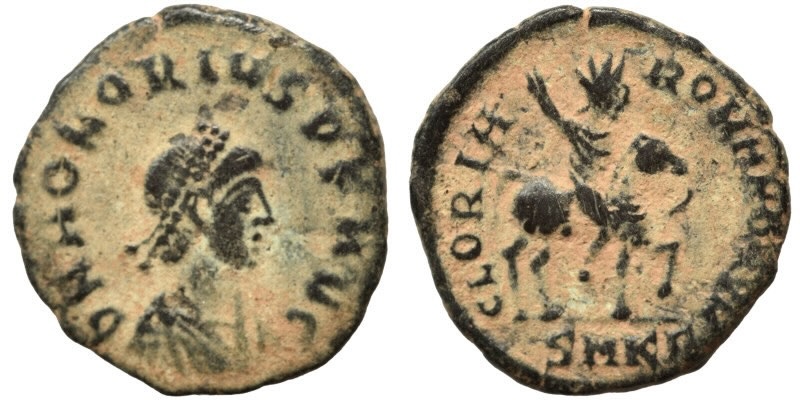 Honorius, 393-423
Honorius, 393-423
16 mm. 2.21 grams.
GLORIA ROMANORVM
Horseman raising hand in greeting.
SMKΓ in exergue (Cyzicus mint)
RIC IX Cyzicus 29c1. Very nice for type. [$27]
(For more coins of this late time period, see Valentinian.)
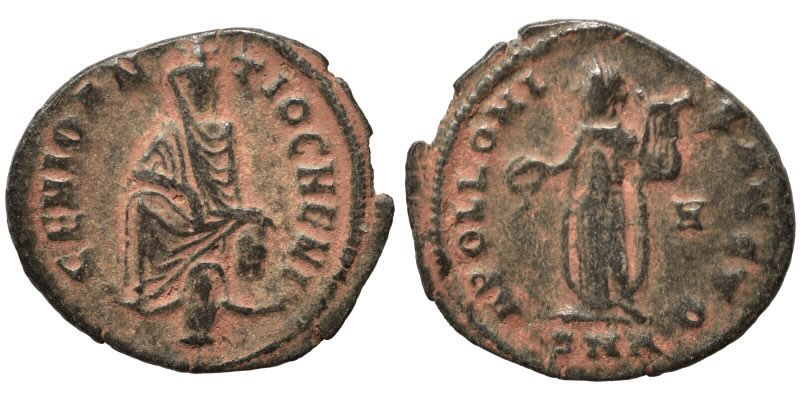 Anonymous civic issue of Antioch from the time of Maximinus II, end of 311-312
Anonymous civic issue of Antioch from the time of Maximinus II, end of 311-312
16 mm. 1.60 grams.
GENIO ANTIOCHINI
Tyche of Antioch seated, river god Orontes swimming below
APOLLONI SANCTO
Apollo standing with patera and his lyre
SMA in exergue (Sacra Moneta Antioch).
Vagi 2954. van Heesch, type 3, plate 11.3. Sear IV 14927.
Not in RIC, but common anyway.
van Heesch (1975) was able to use the mintmarks and especially the large number of active officina (11 officina from A to IA) to show that the whole series was from the time of the persecutions of Christians under Maximinus II (May 310 to July 311), not Julian II (360-363), as formerly thought. In his 1993 article he revised the date to between the end of 311 and December 312, a period of renewed persecutions of Christians. Nice. [$23 SOLD]
 Constantius II, 34-337-361
Constantius II, 34-337-361
anepigrahic
Bust left
*
CONSTAN
TIVS
CAESAR
SMANTH
•
From Antioch mint.
RIC Antioch 60, page 687, struck 324-325 as Caesar.
Well-struck. [$55 SOLD]
 Roman provincial coin of Bostra, capital of Arabia
Roman provincial coin of Bostra, capital of Arabia
Julia Mamae, mother of Severus Alexander (222-235) and the power behind the throne.
21-20 mm. 5.08 grams. Repatinated.
IVLIA MAMAEA AVGVSTA
Tyche left, turreted
COLONIA BOSTRA (in Latin, because Bostra was a colony)
Now called "Bosra" (without the T) in southern Syria, very close to the border with Jordan.
All letters legible and on the flan. [$23]
 Galerius, quarter-follis
Galerius, quarter-follis
This is not the large GENIO POPVLI ROMANI type, rather its much smaller fraction issued at Siscia.
Small at 18-17 mm. 1.99 grams.
MAXIMIANVS AVG (Galerius, Augustus)
GENIO POPVLI ROMANI
SIS in exergue
Siscia mint
Excellent portrait. Very high grade, but corrosion. Fortunately, the portrait is excellent and lovely.
[ $22]
 Constantine with the unusual title
Constantine with the unusual title
FIL AVGG
26.4-23.8 mm. 7.41 grams.
Numerous scratches.
CONSTANTINVS FIL AVGG
(Son of the Augusti)
For the fascinating story of this rare type, see my (long) page:
http://augustuscoins.com/ed/FILAVGG/
GENIO CAESARIS
SMTS for Thessalonica. RIC VI Thessaloncia 32b, page 514.
There are none of Constantine with this title on vcoins (from any mint). There are two of Maximinus II (the only other ruler with this title), one far worse than this one for $80 and another at $165. MA-Shops has one at $323 (parts are better, but the key "FIL AVGG" part is much worse!):
https://www.ma-shops.com/saenn/item.php?id=12667
Numerous cleaning scratches. Rare, with a great story. [$75, reduced to $65]
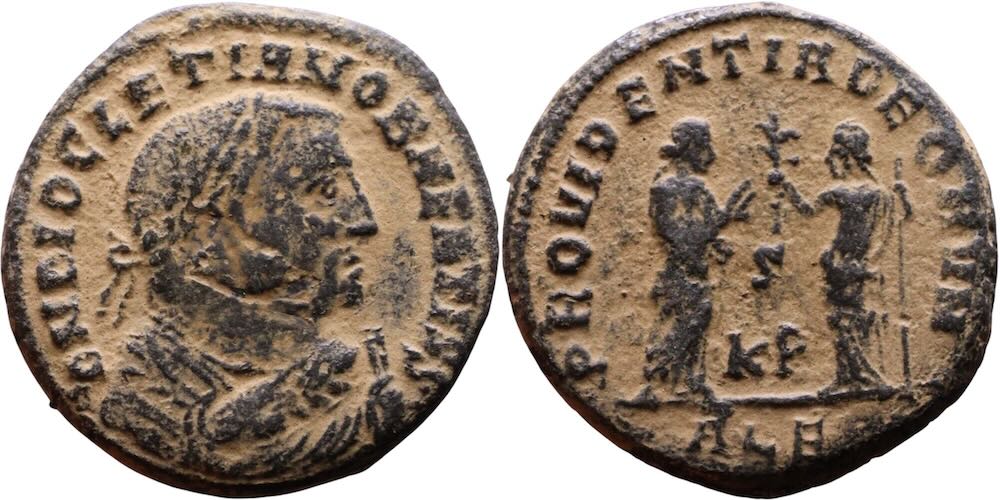 Diocletian abdication piece
Diocletian abdication piece
24 mm. 6.56 grams. Repatinated.
Diocletian reigned 284-305 and retired in 305.
DN DIOCLETIANO BAEATISS [note the unusal obverse legend]
PROVIDENTIA DEORVM
S
KP
ALE
RIC Alexandria 109, Struck "late 308-310"
This is not the largest size abdication type, but the next largest at 24 mm from Alexandria. Scarce. [$39] [As always, I recommend you compare with prices on your (second) favorite site.]
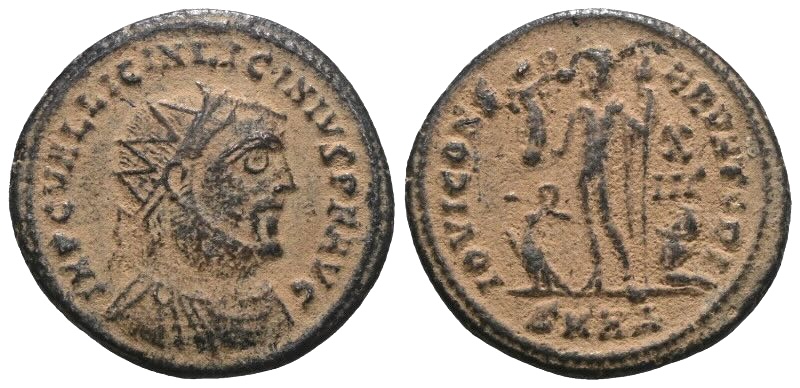 Licinius, 308-324
Licinius, 308-324
21-20 mm. 3.94 grams.
IMP C VAL LICIN LICINIVS PS AVG (nice long version of his name)
IOVI CONSERVATORI
Jupiter holding Victory, eagle and captive at his feet
XIIΓ (12 1/2 for the denomination) in the right field.
Radiate bust for the denomiantion
SMKA for Cyzicus
A nice coin.
[$18]
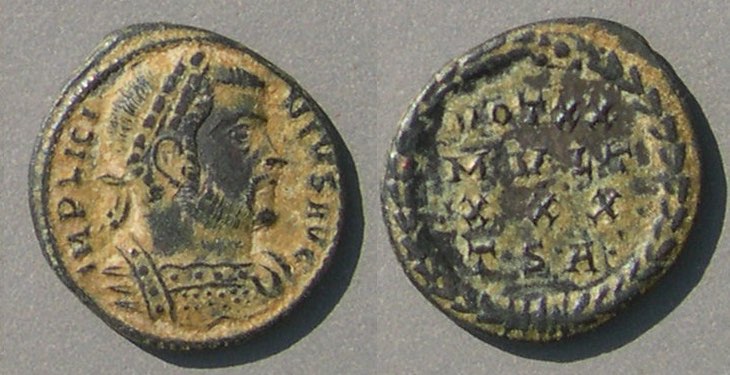 Licinius, 308-324
Licinius, 308-324
19 mm. 2.69 grams.
IMP LICINIVS AVG
VOT XX
MVLT
XXX
T S A
RIC VII Thessalonica 33 "Scarce" "318-319" Strck only at Thessalonica
Sear IV 15382 page 391.
Ex Dan Clark auction 116, lot 160, August 16, 2003.
Vows for 20 years multiplied for 30 years.
[$32, reduced to $29]
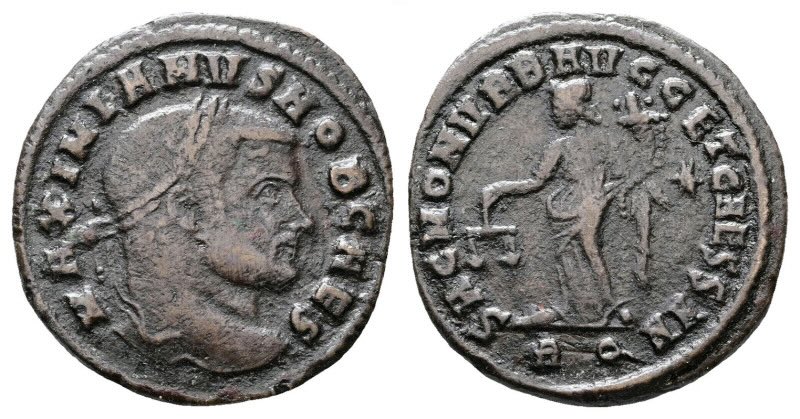
Galerius
29-27 mm. 7.93 grams.
MAXIMIANVS NOB CAES
SAC MON VRB AVGG ET CAESS NN
*
RQ
RIC VI Rome 106b, "c. 302-3"
[$38, reduced to $35]
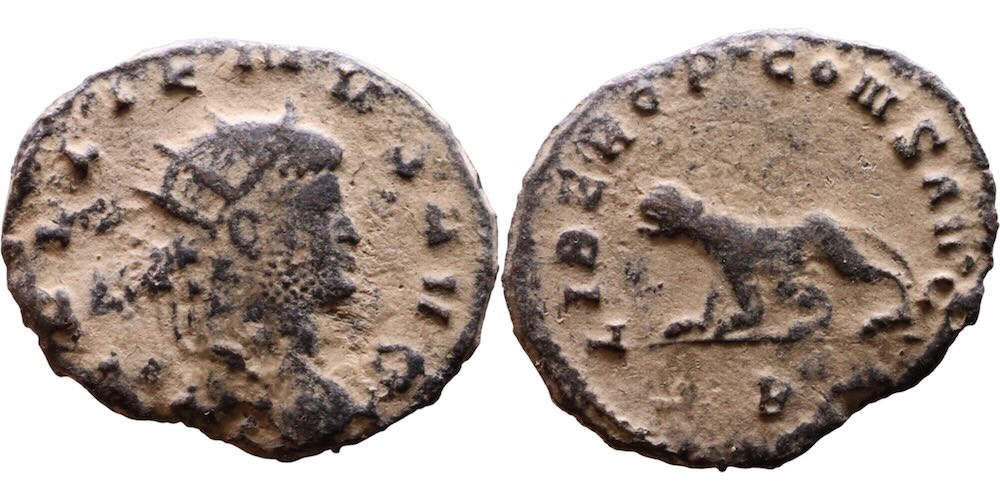
Gallienus, 253-268
21-18 mm. 2.30 grams.
Zoo animal!
Panther left (as the animial of Dionysos)
LIBERO P CONS AVG
Nice panther and reverse legend [$24, reduced to $21]
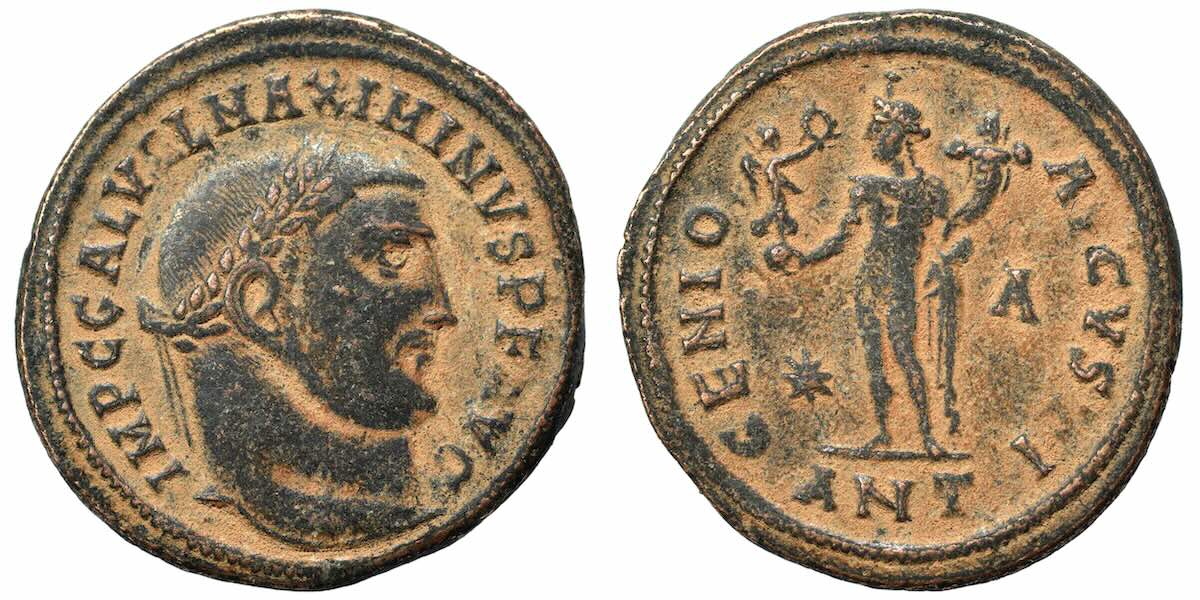 Maximinus II, 305-310-313
Maximinus II, 305-310-313
22.7 mm. Repatinated.
GENIO AVGVSTI
Genius standing left holding Victory on globe
* A
ANT
RIC VI Antioch 162b "311-312"
Great centering and nice portrait. Lovely! [$28]
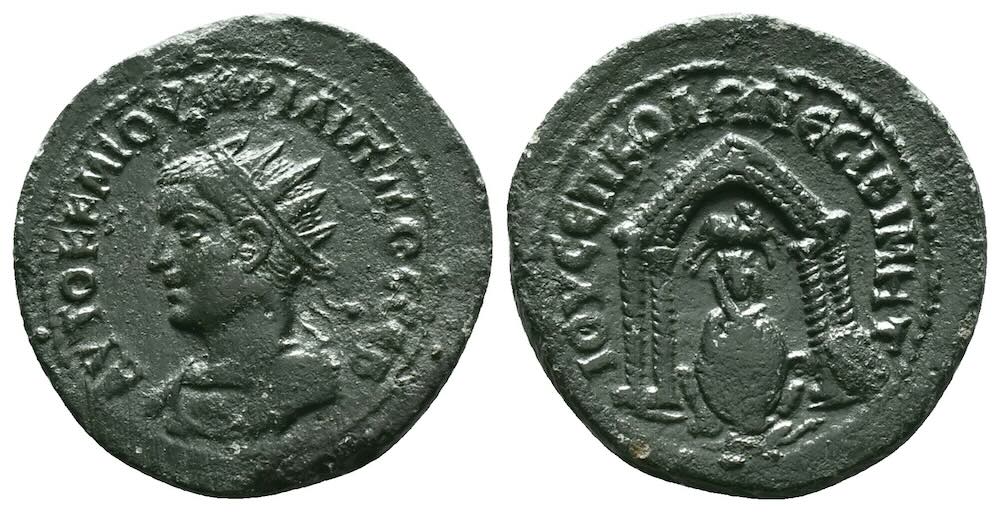 Philip II, 244-249
Philip II, 244-249
26 mm. 13.33 grams. Repatinated. Larger than a quarter and twice as thick.
Nisibis, Mesopotamia (read about Nisibis here)
AVTOK K M IOVΛI ΦIΛIΠΠOC CЄB
Autokrater Caesar Marcus Julius Philippus Sebastos)
The young face makes it Philip II.
Nisibis sometimes distinguished the two Philips by having Philip face right and Philip II face left.
Tetrastyle temple, with triangular pediment, containing statue of city goddess seated facing; above her head, ram (Aries) leaping right; below, river god Mygdonius swimming right.
Rev: IOY CЄΠ KOΛΩ NЄCIBI MHT,
(Julia Septimia Colonia Nisibis Metropolis)
[This "Julia" is a family name for Philip.]
Sear Greek Imperial 4157. BMC Mesopotamia Nesibi [sic] 21, attributed there to Philip I, with a footnote "Some of these may be of Philip Junior, especially nos. 21-4 on which the face appears to be beardless."
RPC VIII "unassigned; ID 2962."
The city name (NECIBI) is clear from 1:00-3:00. Nice portrait. Strong mint name. Good size. [$39]
NOTE: This page now includes Tetrarchal coins (below). It incorporates the previous "Tetrarchy" page.
Please compare prices with those on acsearch and vcoins and any other sites you use. I intend my prices to be below the prices for comparable coins on vcoins.
Begin Roman coins in chronological order
[SOLD]
***** I also have a page of numismatic literature (ancient-coin auction catalogs, books) for sale.
Roman Imperial Silver and AE
Books! Coinage and Finances in the Reign of Domitian: A.D. 81-96 (BAR International) Paperback, 1983. Beautifully hardbound in heavy red cloth covers. Somebody did a nice job having it covered. The original cardcover book and its cover is all there after a flyleaf. Title in black on the spine. Unmarked and seems nearly new. [ $119+$5 shipping.]
(For other books and catalogs, see http://augustuscoins.com/numislit.html ]
Second Century
Trajan (98-117)
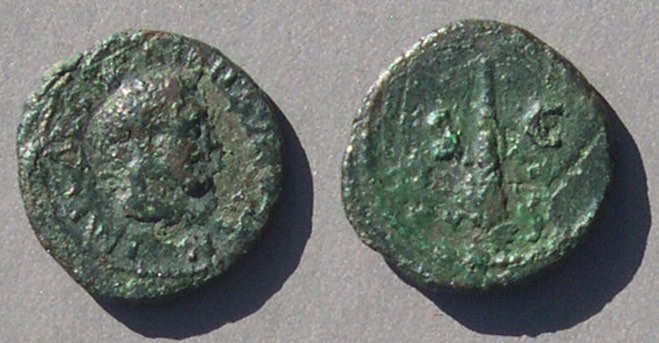 Trajan, 98-117
Trajan, 98-117
Roman imperial quadrans
Hercules/Club with "S C" either side.
15 mm. 2.20 grams.
IMP CAES TRAIAN AVG GERM
Head of Hercules right/his club between SC
Fortunately the obverse legend names Trajan.
RIC II 699, page 293, plate XII, 212.
ex Baldwin's in London, May 17, 1988 (no ticket)
[$29, reduced to $23]
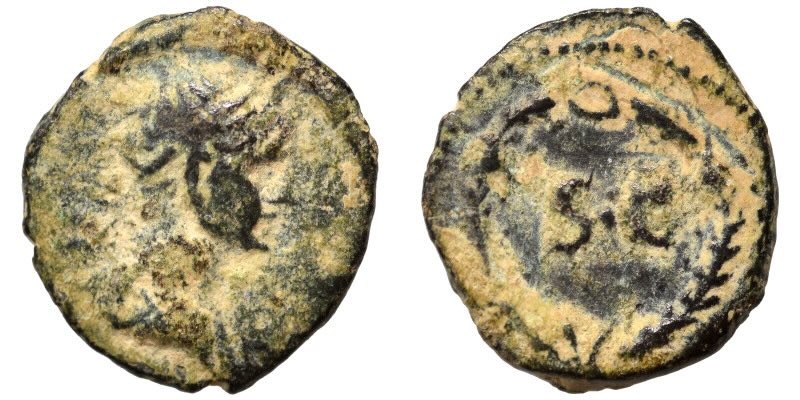 Trajan, 98-117
Trajan, 98-117
The smallest Roman denomination! Sometimes called an "uncia." It is much smaller than a quadrans.
Struck very near the end of his reign, c. 117.
12 mm. 0.84 grams. Tiny!
His bust right with no legend.
"SC" in wreath.
Sear II 3250, page 170 "Rome, 112-117"
RIC Trajan 443, says probably 101-103 (unlikely, since there is a short-lived similar type of Hadrian)
BMC 1883. p. cvi "Very probably of Roman mintage--possibly Antioch."
The only other coin of a similar type is of Hadrian, distinguished only by its portrait of Hadrian.
Recognizable bust of Trajan and clear "SC" in wreath. Tiny! [$27 SOLD]
It is nice considering it is so small. PRC III 3681 Antioch "chalkous" "product of Rome." "Struck for circulation in Syria"
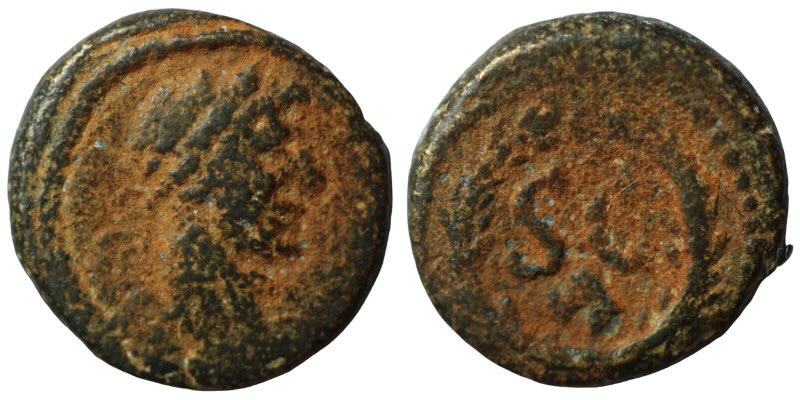 Hadrian, 117-138
Hadrian, 117-138
The smallest Roman denomination! Sometimes called an "uncia." It is much smaller than a quadrans.
It may be a "half-quadrans."
Struck very near the beginning of his reign, c. 117.
10.5 mm. 1.06 grams. Tiny!
His bust right with no legend.
"SC" in wreath.
Sear II 3705, page 170 "Rome, 117-118"
RIC Hadrian 629b.
BMC 1883. p. cvi "Very probably of Roman mintage--possibly Antioch."
The only other coin of a similar type is of Trajan, distinguished only by its portrait of Trajan.
Recognizable bust of Hadrian and clear "SC" in wreath. Tiny! [$27]
It is so small! PRC III 3681 Antioch "chalkous" "product of Rome." "Struck for circulation in Syria"
Another: (Before a few years ago I don't recall these ever being offered. Maybe they were too small for life-sized photos! I find them really interesting in hand for their size.
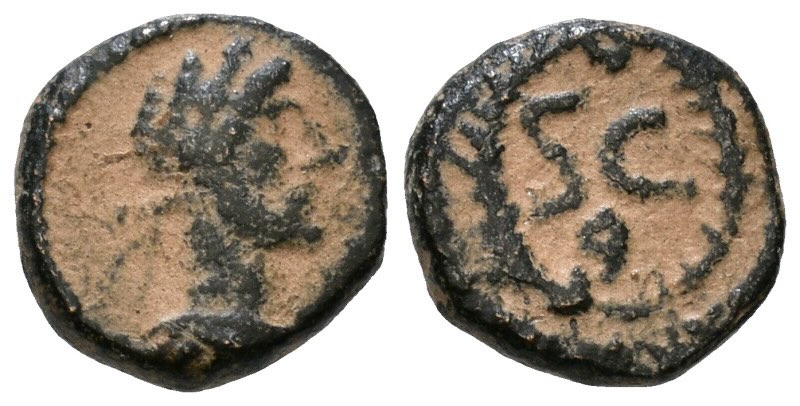 Hadrian, 117-138
The smallest Roman denomination! Sometimes called an "uncia." It is much smaller than a quadrans.
Hadrian, 117-138
The smallest Roman denomination! Sometimes called an "uncia." It is much smaller than a quadrans.
It may be a "half-quadrans."
Struck very near the beginning of his reign, c. 117.
9.5 mm. 1.00 grams. Tiny!
His bust right with no legend.
"SC" in wreath.
Sear II 3705, page 170 "Rome, 117-118"
RIC Hadrian 629b.
BMC 1883. p. cvi "Very probably of Roman mintage--possibly Antioch."
The only other coin of a similar type is of Trajan, distinguished only by its portrait of Trajan.
Recognizable bust of Hadrian and clear "SC" in wreath. Tiny! [$33 SOLD] ($3 off the total if you also buy the corresponding Trajan above as a pair)
It is so small! PRC III 3681 Antioch "chalkous" "product of Rome." "Struck for circulation in Syria"
Antoninus Pius (138-161)
[none]
Third Century:
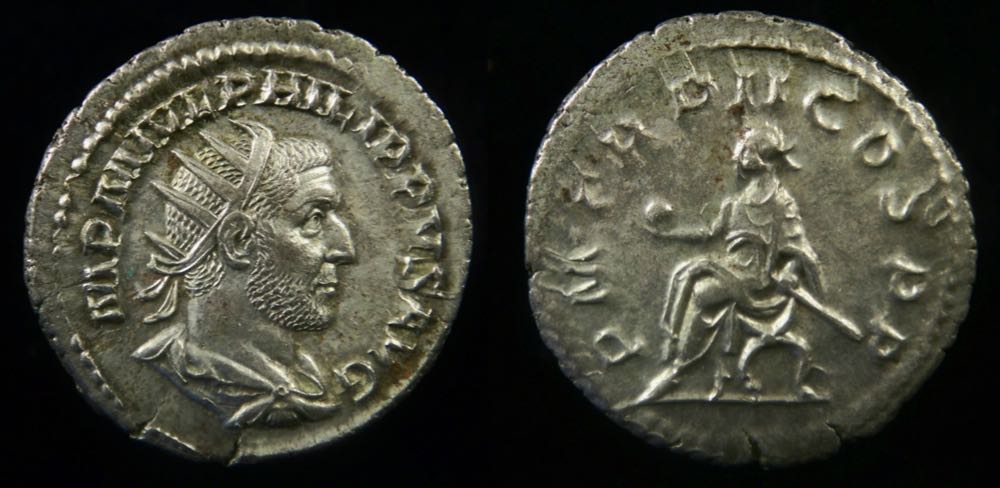 Enlarged! (Because the portrait is so great!)
Enlarged! (Because the portrait is so great!)
Look at it closely.
Philip I, 244-249, His first isssue, dated to 245. He does not have coins dated to 244.
23 mm. Antoninianus. 12:00. 3.74 grams.
IMP M IVL PHILIP{PVS AVG
Magnificent portrait right on a large flan.
PM TRP II COS PP
Sear 3.8843
RIC 2b. Plate 5.16.
If you only want one coin of Philip for your portrait series, this could be the one. [$145. reduced to $135 SOLD]
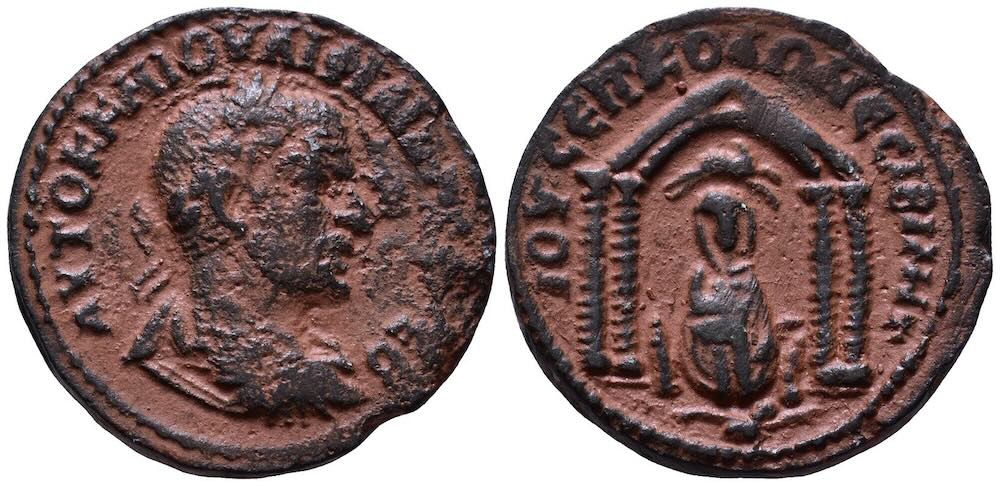 Philip I, 244-249
Philip I, 244-249
Struck at Nisibis, Mesopotamia
26-25 mm. 9.31 grams. Repatinated. The size of a quarter and twice as thick.
AVTOK K M IOVΛI ΦIΛIΠΠOC CЄB
(Autokrater Caesar Marcus Julius Philippus Sebastos)
The beard makes it Philip I.
Rev: IOY CЄΠ KOΛΩ NЄCIBI MHT,
(Julia Septimia Colonia Nisibis Metropolis)
[This "Julia" is a family name for Philip.]
Tetrastyle temple, with triangular pediment, containing statue of city goddess seated facing; above her head, ram (Aries) leaping right; below, river god Mygdonius swimming right.
Sear Greek Imperial Coins 3970. BMC Mesopotamia Nesibi [sic, that is how it is spelled on coins, although it is spelled "Nisibis" in literature] 17. RPC VIII "unassigned; ID 2824."[$34]
 Philip II, 244-249
Philip II, 244-249
25.6 mm. 8.89 grams. Repatinated. Larger than a quarter and twice as thick.
Nisibis, Mesopotamia
AVTOK K M IOVΛI ΦIΛIΠΠOC CЄB
Autokrater Caesar Marcus Julius Philippus Sebastos)
The young face makes it Philip II.
Nisibis sometimes distinguished the two Philips by having Philip face right and Philip II face left.
Tetrastyle temple, with triangular pediment, containing statue of city goddess seated facing; above her head, ram (Aries) leaping right; below, river god Mygdonius swimming right.
Rev: IOY CЄΠ KOΛΩ NЄCIBI MHT,
(Julia Septimia Colonia Nisibis Metropolis)
[This "Julia" is a family name for Philip.]
Sear Greek Imperial 4157. BMC Mesopotamia Nesibi [sic] 21, attributed there to Philip I, with a footnote "Some of these may be of Philip Junior, especially nos. 21-4 on which the face appears to be beardless."
RPC VIII "unassigned; ID 2962."
The city name (NECIBI) is clear from 1:00-3:00. [$35]
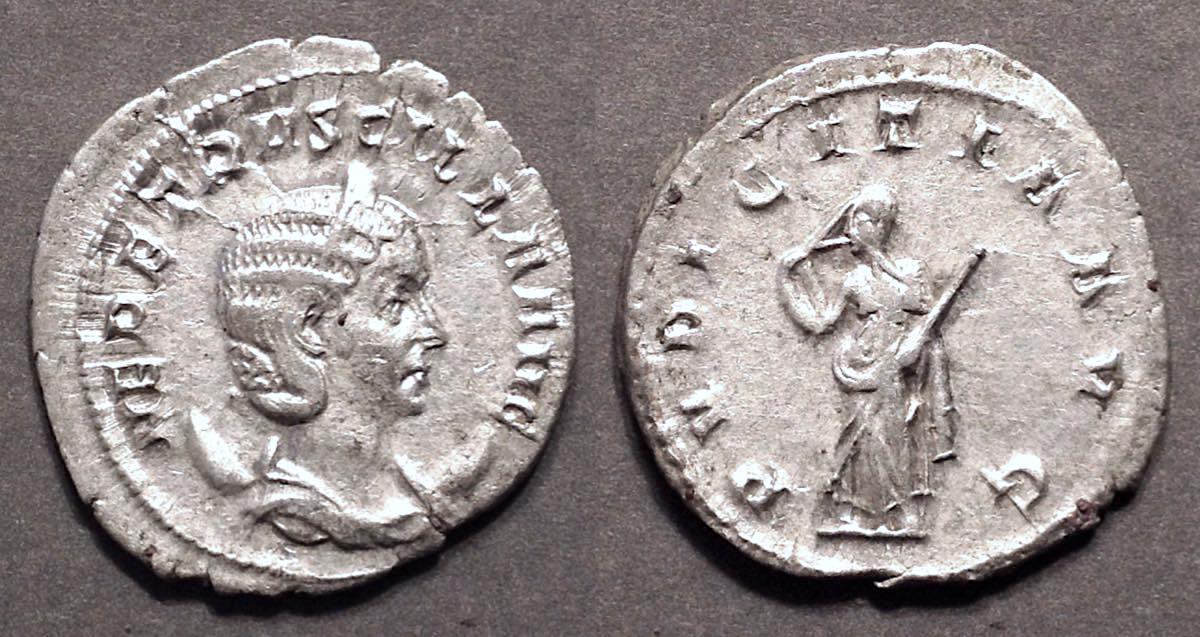 A lovely portrait for the portrait series.
A lovely portrait for the portrait series.
Herennia Etruscilla, wife of Trjan Decius who reigned 249-251
HER ETRVSCILLA AVG
Please please go look at other coins of Herennia. She often/usually has an unattractive face. You have to look hard to find one as pleasing as this one.
PVDICTIA AVG (modesty)
RIC IV.III (under Trajan Decius) 58b, page 127, plate 11.4. (RIC's coin is not quite as nice)
Sear III 9494.
Ancient coins are ancient art, as well as history. This particular coin is art of a higher order than almost all of her other coins.
[$145, reduced to $125 + $6 shipping in the US]
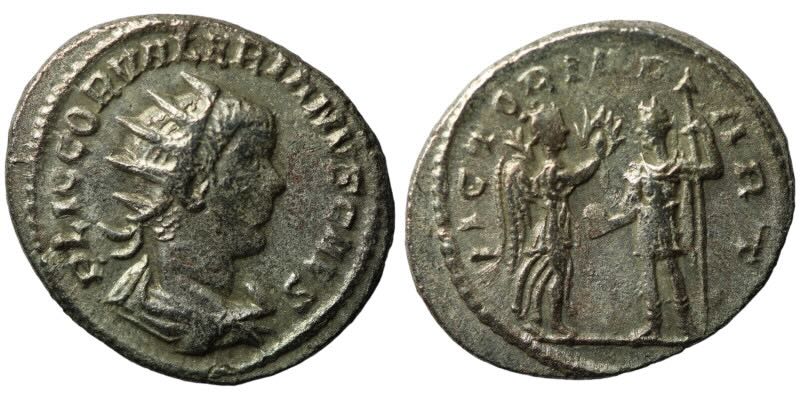 Valerian II, son of Gallienus
Valerian II, son of Gallienus
VICTORIA PART
I love coins relating to wars between Roman and Persia. This is a scarce type (primarily for Valerian I) which ironically references Valerian's (untimately disastrous) war with "Parthia" (by then we call them Sasanians)
Comparable coins on vcoins cost far more. [$59, reduced to $55] An interesting historical type.
Central Empire, Claudius II (268-270) and later:
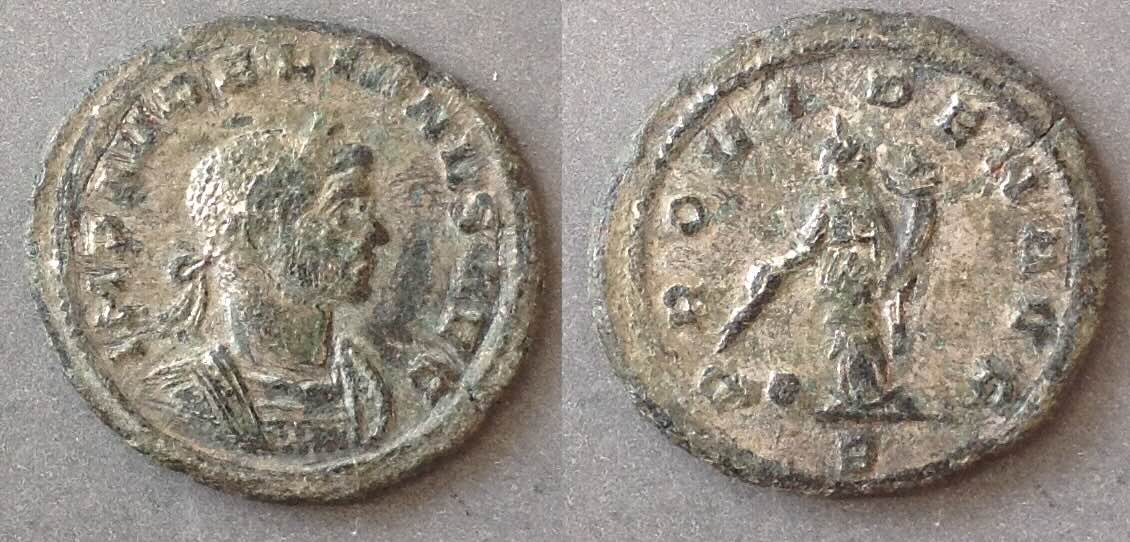 Aurelian, 270-275
Aurelian, 270-275
Very rare type of the denarius denomination.
19 mm. 2.41 grams.
Everone knows that most coins of Aurleian are radiate and he has a type as a laureate denarius: VICTORIA AVG. That type is scarce compared to his antoniniani or aureliani. Did you know he had other, far rarer, types of denarii too?
This one is highly unusual. Lots of silvering.
RIC 69. Estiot 248, 249 on page 166. "11th issue, beginning 275 - Sept. 275." page 304, Rome mint. Part of his reformed coinage.
ex Numismatica Zagreb March 7, 2005, at $112. I bet I see 50 of his common denarius VICTORIA AVG for every denarius that is not VICTORIA AVG.
A rarity. [$165]
For a page of ancient imitations from the third century, see here.
Tetrarchy begins here!
Diocletian (284-305)
Maximian (286-305 and later)
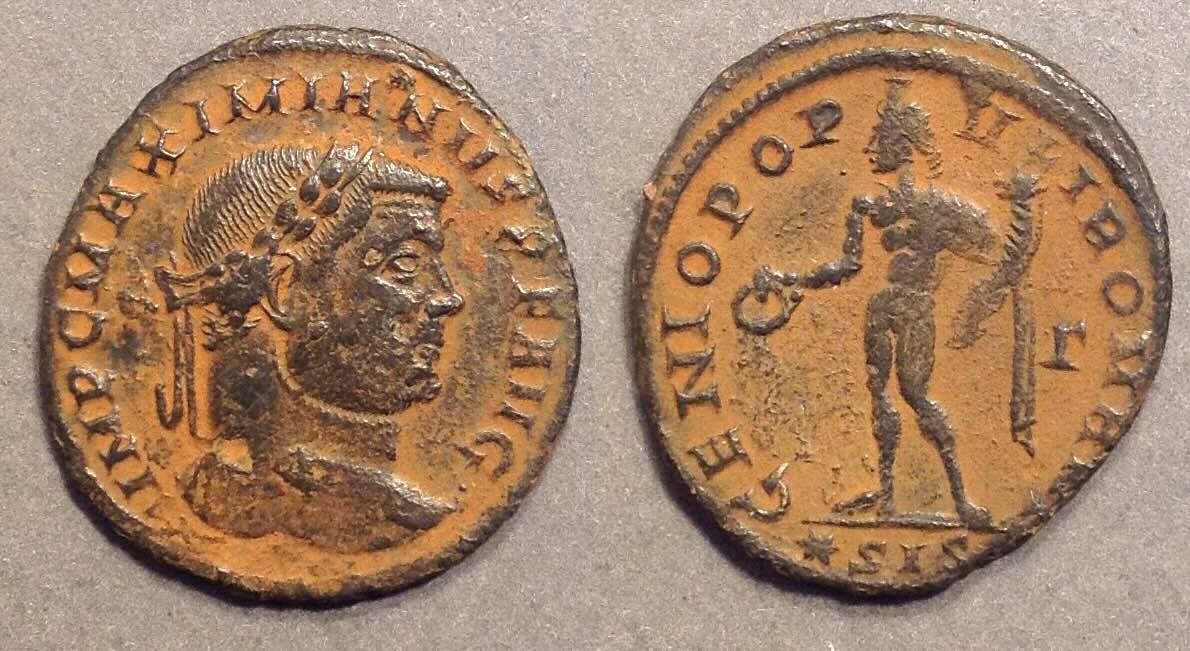 Maximian, 286-305
Maximian, 286-305
27.4-25.6 mm. 7.90 grams. Repatinated.
Struck 295-295 at Siscia
RIC VI Siscia 95b or 85b (same type)
GENIO POPVI ROMANI
Γ
*SIS
Big coin with nice details and some pitting on the face
[$34, reduced to $29]
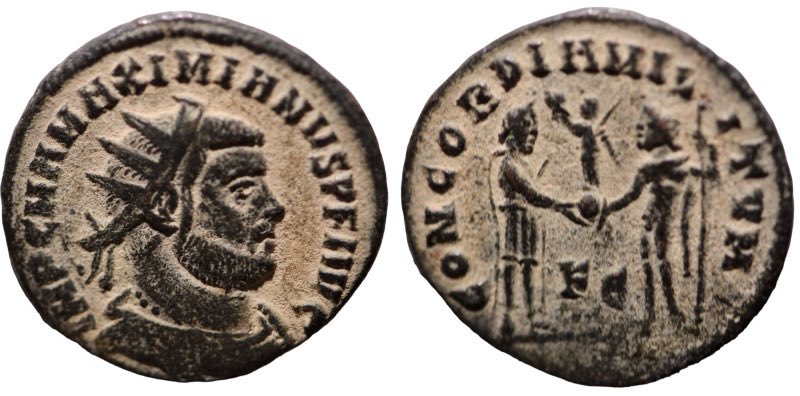 Maximian. (286-305 AD).
Maximian. (286-305 AD).
20mm, 2.71g
Cyzicus
IMP C M A MAXIMIANVS P F AVG. radiate cuirassed bust of Maximian right.
CONCORDIA MILITVM. Jupiter standing left presents Victory on a globe to Maximianus standing right. White cover. [$23, reduced to $19 SOLD]
Club and lion-skin!
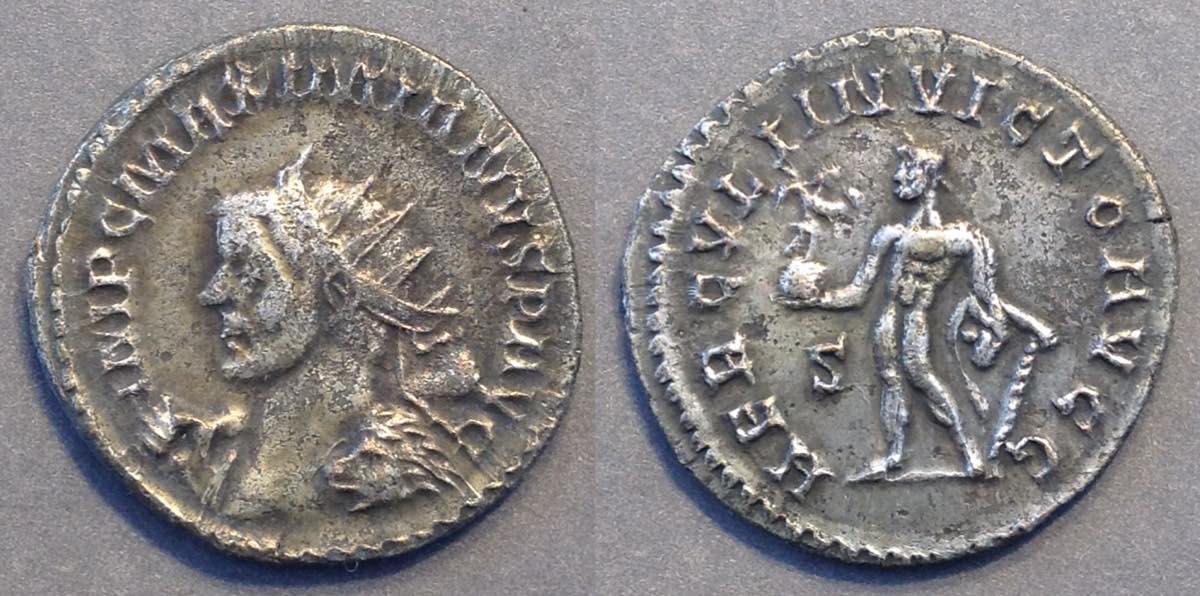 Maximian, 286-305.
Maximian, 286-305.
22 mm. 4.23 grams. Heavy with better silver than typical.
IMP C MAXIMIANVS AVG
HERCVLI INVICTO AVGG
Hercules standing left holding Victory on globe, lion-skin over left arm, leaning on club.
S in left field, nothing in exergue.
Obverse: radiate bust left holding club over far shoulder, lion skin over near (his left) shoulder.
RIC V.II Maximian 367, page 263, "Lugdunum, 289"
Bastien 190 p.152, 5th emission, 2nd officina (287-289 AD).
Sear 13132.
Rare bust type. Lots of silvering. [$295, reduced to $235, reduced to $189 SOLD] Please compare with prices elsewhere.
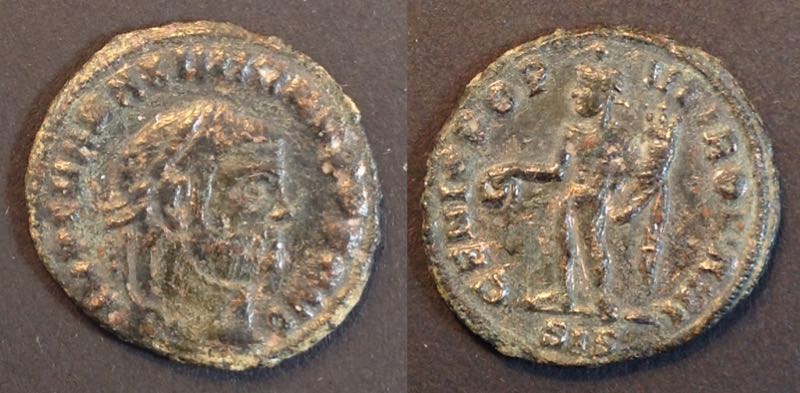 Quarter Follis of Siscia
Quarter Follis of Siscia
19 mm.
Maximian
IMP C MA MAXIMIANVS PF AVG
GENIO POPVLI ROMANI
SIS
This is not the usual full-size follis, rarther the scarcer (but not rare) "quarter follis".
RIC Siscia 146, "R3" (RIC rarities are out of date.)
plate IX
Failmezger 29 [$16, reduced to $13 SOLD]
Constantius I (293-305-306)
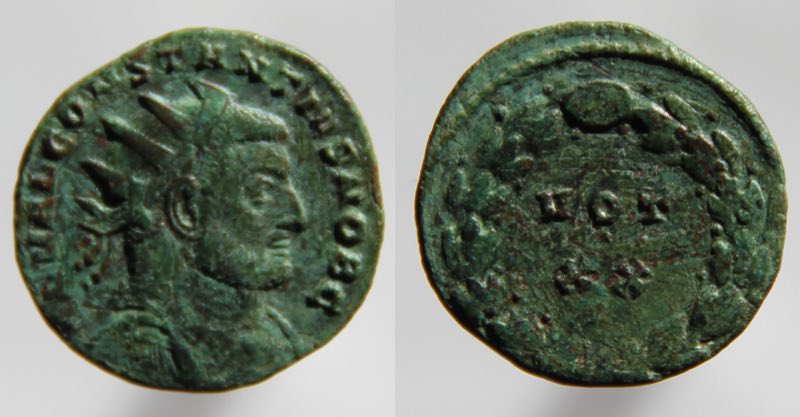 Constantius, 293-305-306
Constantius, 293-305-306
20-19 mm
Struck as Caesar
IMP VAL CONSTANTIVS NOB C
VOT XX in wreath
No visible officina number
RIC VI Rome 87e variety. "c.297-8." Footnote 2 says some apparently have no officina number. [$49, reduced to $31]VOT XX is hard to explain for Constantius with this date. It might be the vows of Diocletian (not Constantius) reconfirmed at year 15 (as proposed by RIC). It might be the coin is really from c. 303 (as the Carthage coins above) and this is vows suscepta for Constantius on the occasion of his ten-year vows. Of, it might be really from c. 303 and the vow number belongs to Diocletian. It is certainly the case that vow numbers can belong to the senior ruler and not the ruler named on the coin.
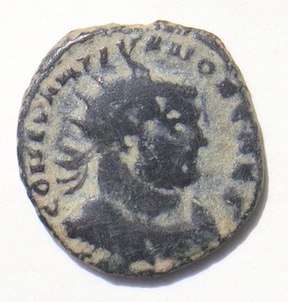
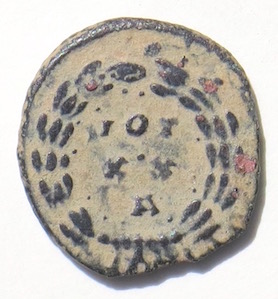
[$39, reduced to $21] Constantius I. Struck c. 297-8 at Rome. 19 mm. 3.14 grams.
VOT XX A in wreath.
RIC VI Rome 88a. page 360.
A reference to the "20 years" intended for the tetrarchy.
Rare. None on vcoins or MA-Shops as of this writing.
Galerius (293-305-311)
Maxentius (306-312)
Maximinus II, 305-311
21.7 mm. 4.69 grams. Repatinated.
GENIO AVGVSTI
Genius hold head of Sol
Antioch mint
IMP C GAL VAL MAXIMINVS PF AVG
RIC Antioch 164b, dated "312"
[$18]
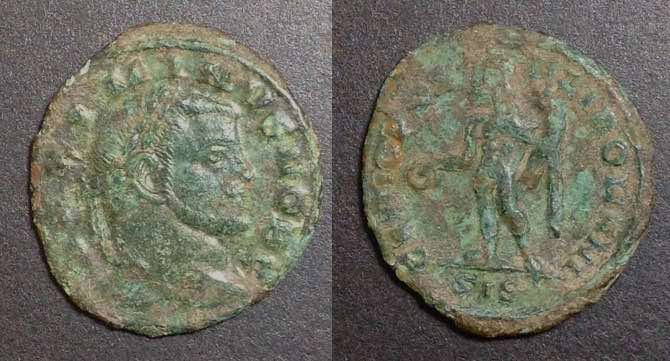 Maximinus II, 305-310-313
Maximinus II, 305-310-313
19 mm.
Struck 305-306
quarter follis
GENIO POPVLI ROMANI
SIS for Siscia
RIC Siscia 171b
The short version of his obverse legend
MAXIMINVS NOB C [$33, reduced to $14]
Civic Pagan Coins of the time of Maximinus II (c. 310)
[SOLD]
Licinius (308-324)
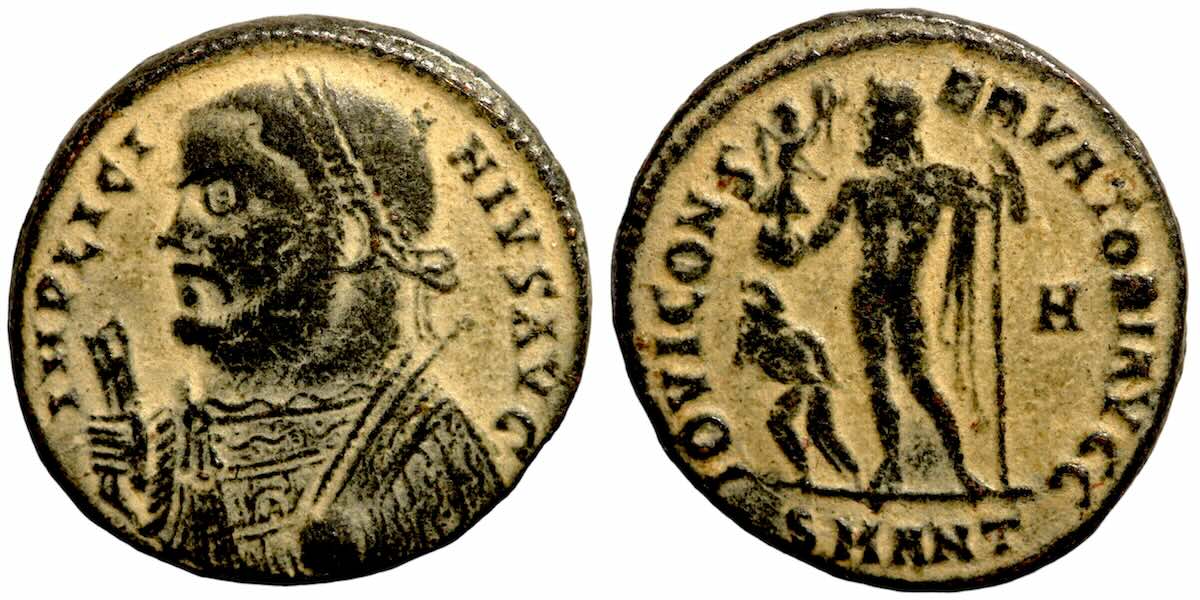 Licinius I, 308-324
Licinius I, 308-324
19-18 mm. 3.45 grams. Repatinated.
IOVI CONSERVATORI AVGG
Jupiter holding Victory on globe with captive to left. (Compare to the previous coin without captive) Other varieties have an eagle or palm branch or wreath)
H
SMANT
RIC VII Antioch 27H "r2" (but many similar)
Sear IV 15239 p. 379.
[$24]
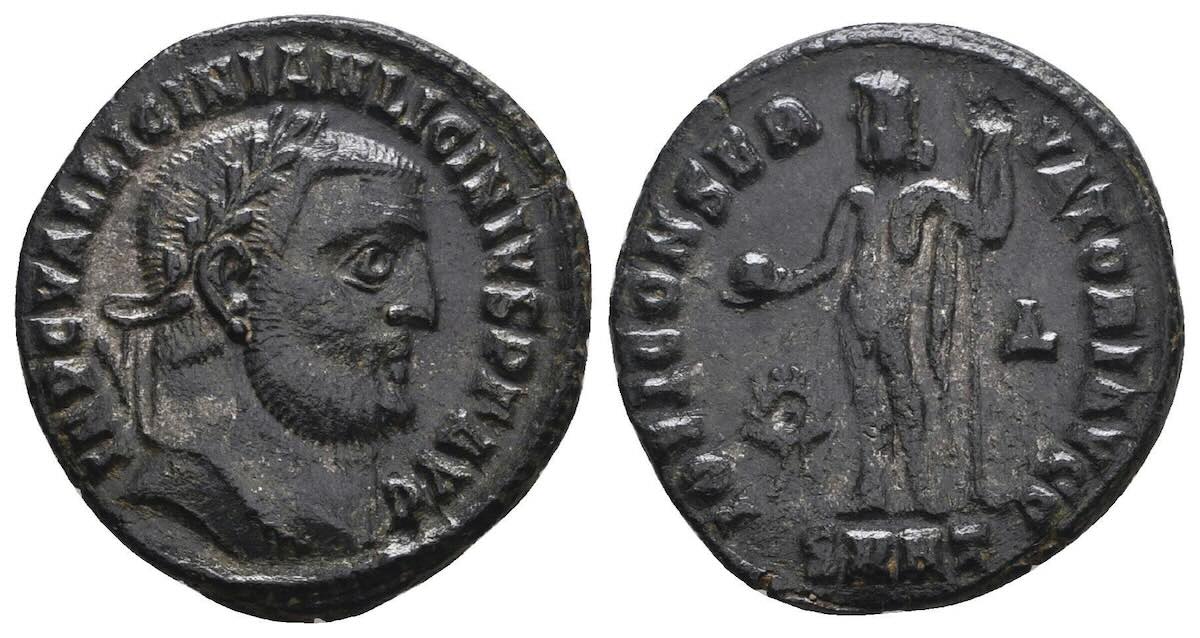
Licinius I, 308-324
22.7-21.3 mm. 4.56 grams.
Struck "c. 312" at Heraclea.
IMP C VAL LICINIAN LICINIVS PF AVG (long name!)
IOVI CONSERVATORI AVGG
Jupiter holding globe with wreath to left.
Δ
SMHT
RIC VII Heraclea 541 with officina Δ not in RIC.
Sear IV 15233 p. 379.
[$45] for the long version of his name and for being a minor variety not in RIC.
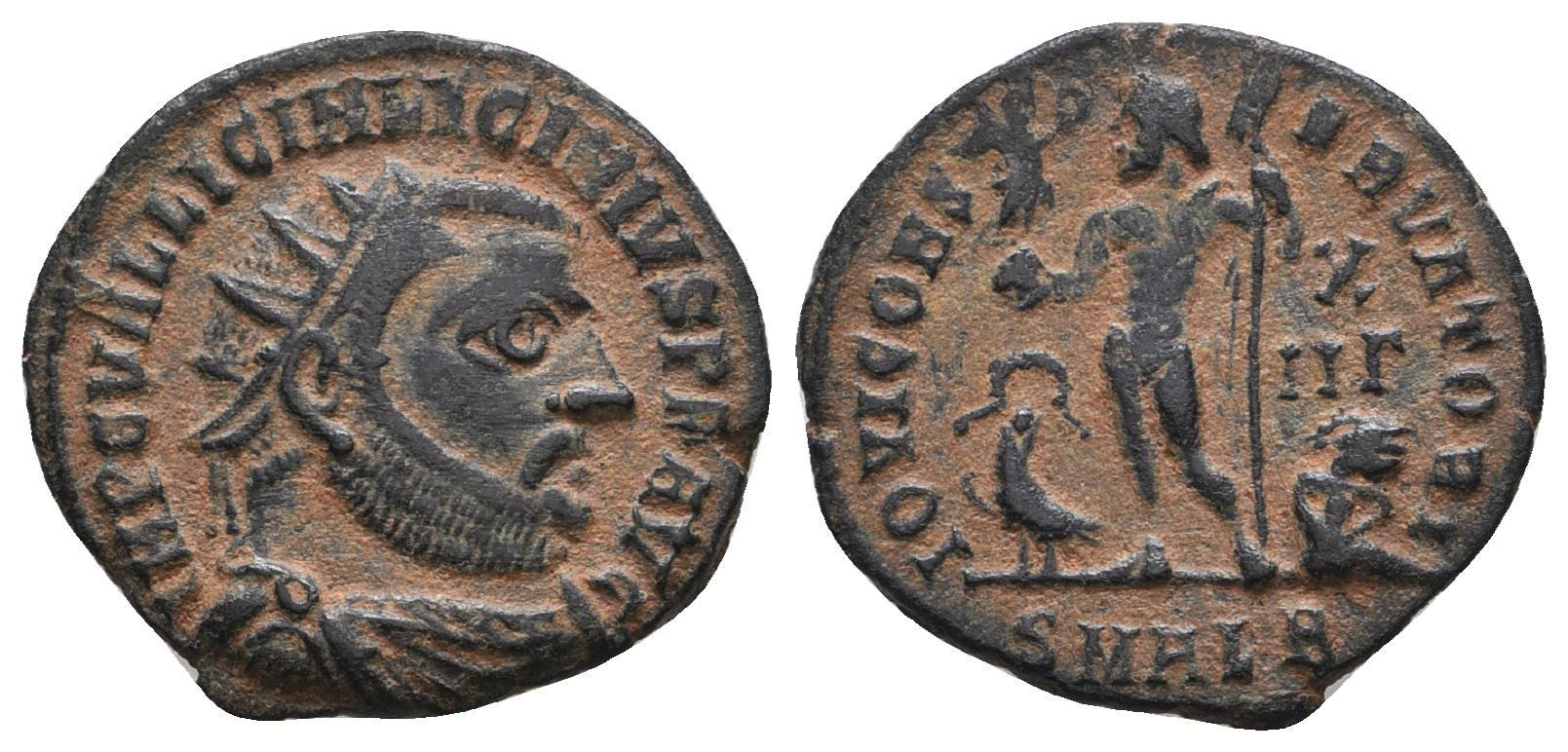 Licinius, 308-324
Licinius, 308-324
19 mm.
IOVI CONSERVATORI
SMALB for Alexandria.
The new 12 1/2 denomination: X/IIΓ
Jupiter with Victory on globe, eagle and captive at feet.
[$15]
This type is very common, but often, as here and the next coin, remarkably nice and inexpensive.
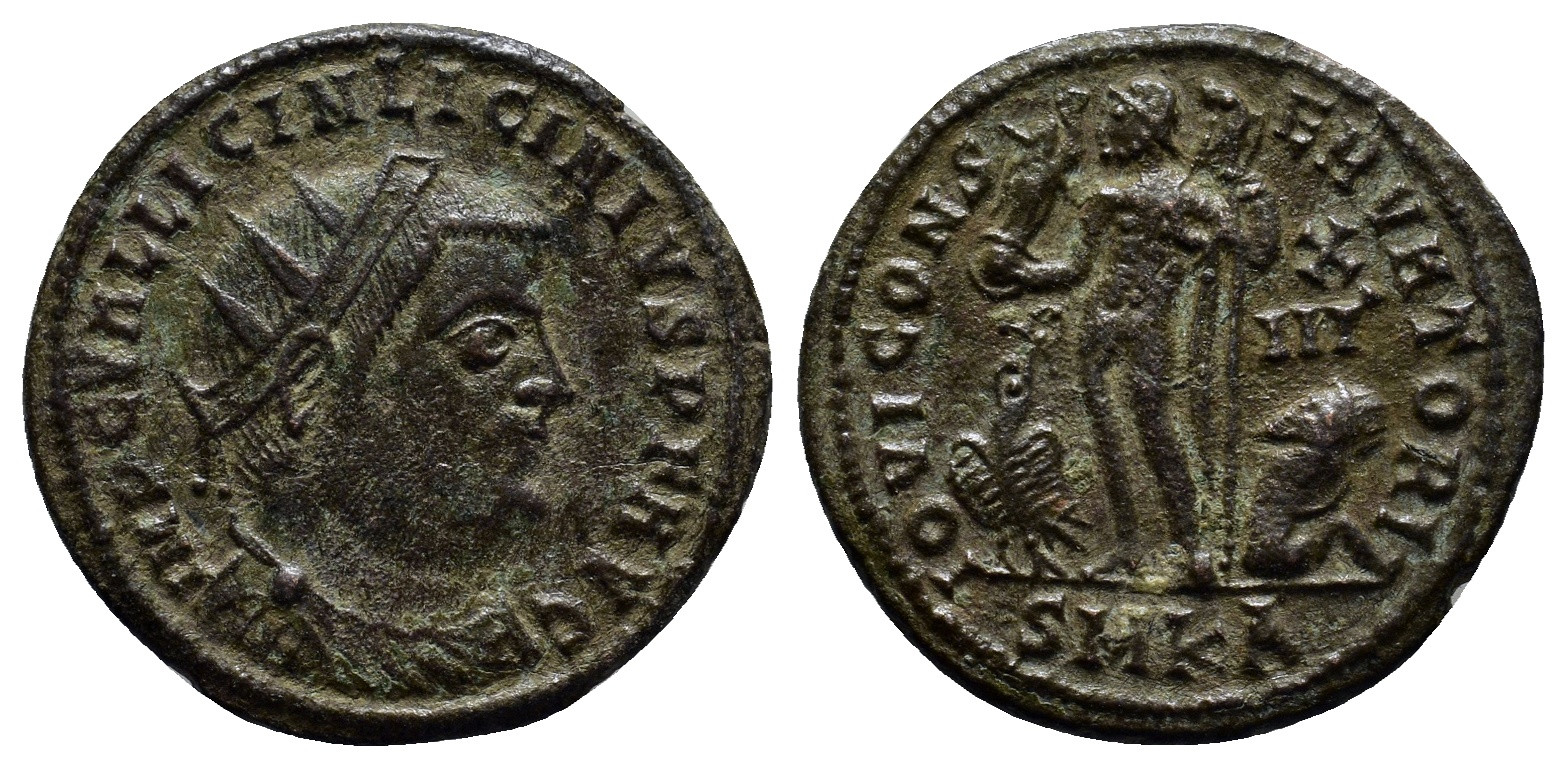 Licinius, 308-324
Licinius, 308-324
19 mm.
IOVI CONSERVATORI
SMKA for Cyzicus.
The new 12 1/2 denomination: X/IIΓ
Jupiter with Victory on globe, eagle and captive at feet.
[$23] Really lovely in hand and a bit better profile than the photo suggests.
Great centering. Great detail on the eagle. You can see the captive's face (How can they engrave the die!?)
 Licinius
Licinius
19.5-17.9 mm.
IOVI CONSERVATORI
SMANTZ for Antioch mint
X II Γ in the field for 12 1/2, half the "25" denomination.
eagle holding wreath, captive, and Jupiter holding Victory on globe, crowning him.
[$8]
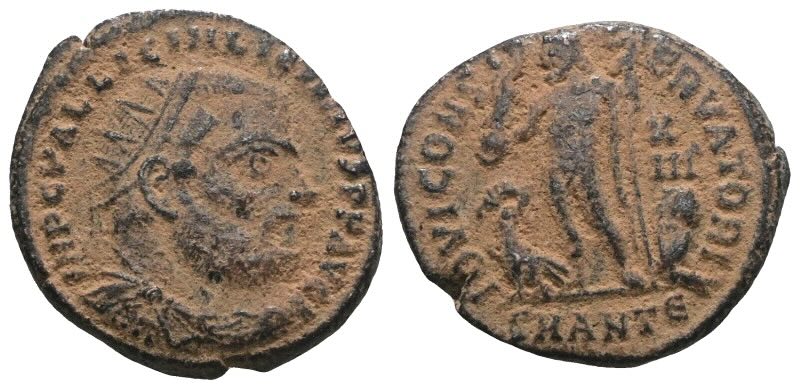 Licinius, 308-324
Licinius, 308-324
19-17 mm
IOVI CONSERVATORI
XIIΓ for 12 1/2, the denomination.
SMANTЄ
[$9]
Licinius II (317-324)
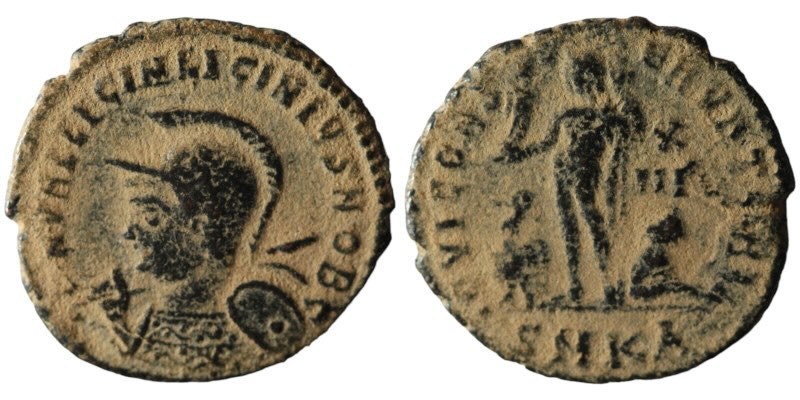 Licinius II, 317-324
Licinius II, 317-324Helmeted bust left
XIIΓ denomination.
SMKA for Cyzicus
[$8]
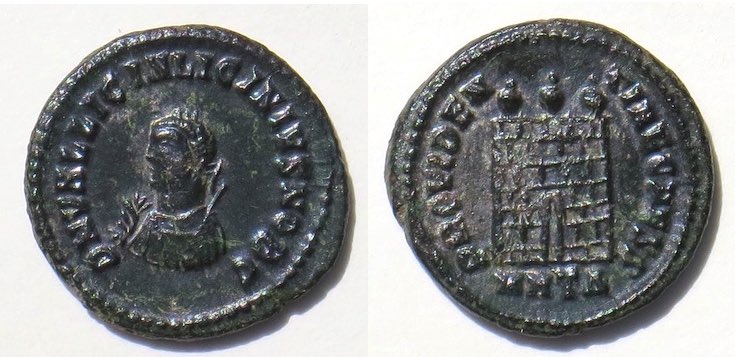
Licinius II, 317-324
19 mm. Tiny head left with scepter and mappa, struck 317
RIC VII Heraclea 19
"Camp gate" PROVIDENTIAE CAESS, MHTDelta
Very little wear, silvering mostly tarnished to glossy black. Bold strike.
A really cute tiny head! Bold head and legend. Splendid! [$59, reduced to $45]
 Okay, it is not an ancient coin, and not ancient, but it is interesting. A small thimble, 14 mm diameter, 15.3 mm deep. (Too small for even my little finger.)
Okay, it is not an ancient coin, and not ancient, but it is interesting. A small thimble, 14 mm diameter, 15.3 mm deep. (Too small for even my little finger.)
I know almost nothing about it. I bought it from the "artifacts" section of an ancient-coin auction. Thimbles are a medieval invention, not ancient.
I will ship it in a small but strong box inside an envelope so it doesn't get crushed in the mail.
[$9, reduced to $6 + $6 shipping (It is too thick for a regular envelope)] (If you also order coins, the coins will not add to the shipping cost unless the coins are expensive.)
Return to the top of this page.
Next Page: Constantinian (306-364)
Second next: Roman of Valentinian and later (364-491 AD)
To order, or simply to ask me questions, write me, Warren, at

 .
.  Galerius, 293-305-311
Galerius, 293-305-311 Valentinian II
Valentinian II
 Constantius II
Constantius II Julian II, the Apostate
Julian II, the Apostate Honorius, 393-423
Honorius, 393-423

 Roman provincial coin of Bostra, capital of Arabia
Roman provincial coin of Bostra, capital of Arabia Galerius, quarter-follis
Galerius, quarter-follis Constantine with the unusual title
Constantine with the unusual title Diocletian abdication piece
Diocletian abdication piece Licinius, 308-324
Licinius, 308-324 Licinius, 308-324
Licinius, 308-324

 Maximinus II, 305-310-313
Maximinus II, 305-310-313 Philip II, 244-249
Philip II, 244-249 Trajan, 98-117
Trajan, 98-117
 Hadrian, 117-138
Hadrian, 117-138

 Philip I, 244-249
Philip I, 244-249 Philip II, 244-249
Philip II, 244-249 A lovely portrait for the portrait series.
A lovely portrait for the portrait series. Valerian II, son of Gallienus
Valerian II, son of Gallienus Aurelian, 270-275
Aurelian, 270-275 Maximian, 286-305
Maximian, 286-305


 Constantius,
Constantius, 

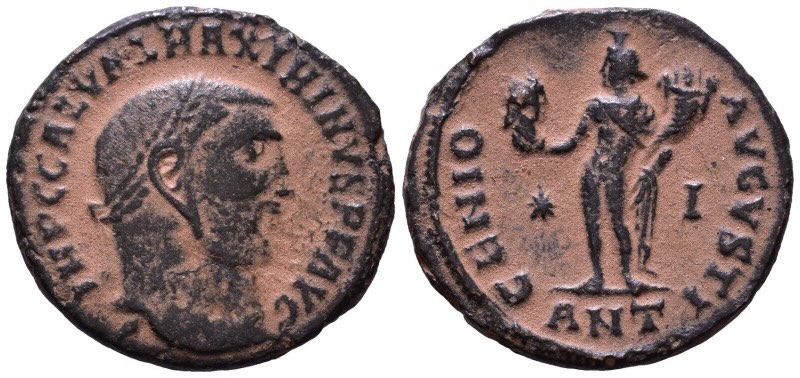
 Maximinus II,
Maximinus II, 
 Licinius, 308-324
Licinius, 308-324 Licinius, 308-324
Licinius, 308-324 Licinius
Licinius Licinius, 308-324
Licinius, 308-324 Licinius II, 317-324
Licinius II, 317-324
 Okay, it is not an ancient coin, and not ancient, but it is interesting. A small thimble, 14 mm diameter, 15.3 mm deep. (Too small for even my little finger.)
Okay, it is not an ancient coin, and not ancient, but it is interesting. A small thimble, 14 mm diameter, 15.3 mm deep. (Too small for even my little finger.)